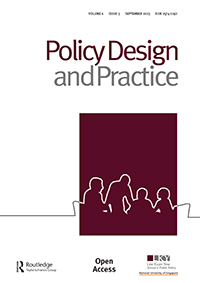模糊的边界:Muhtarlık是土耳其政策制定的正确空间
IF 2.6
Q1 PUBLIC ADMINISTRATION
引用次数: 1
摘要
土耳其中央政府的行政结构包括一个名为muhtarlık的独一无二的自治单位,它横跨农村和城市社区,在全国拥有超过5万个职位。虽然是中央政府的一部分,但muhtarlık由地方选举管理,被认为是一个协调公民,地方政府和中央政府的混合机构。Muhtarlık起源于1829年奥斯曼帝国晚期,作为国家等级制度现代化的尝试,并作为行政结构中最小的单位继续存在至今。然而,悠久的历史也使得机构所占据的空间界限模糊。本文关注的是muhtarlık这个模糊的空间作为一个可能的政策制定孵化器和所有相关利益相关者的可访问空间。特别是,本文通过对两个非常不同的muhtarlıks在伊斯坦布尔的案例研究,了解这一独特的行政单位的性质。研究得出的结论是,muhtarlık与公众在地理、社会和关系上的接近性创造了一个巨大的网络实例。本文通过分析与政策制定和设计相关的两个过程,即政策分析和设计思维过程的并置,为政策制定的跨学科方法做出了贡献,以模拟一个动态的政策制定过程,提供了一种参与式的方法。通过分析和观察,结合公民参与、政府传统和设计师思维的宝贵经验,帮助探索空间的可能性。本文章由计算机程序翻译,如有差异,请以英文原文为准。
Blurred boundaries: Muhtarlık as the right space for policy making in Turkey
Abstract Turkey’s central government’s administrative structure includes a one-of-a-kind autonomous unit called muhtarlık that spans rural and urban neighborhoods with over 50,000 posts all over the country. Despite being a part of the central administration, muhtarlık is administered by local elections and is considered a hybrid institution that mediates citizens, the local government and the central administration. Muhtarlık originates in the late Ottoman Empire in 1829 as an attempt in modernizing state hierarchies and manages to continue its existence till now as the smallest unit of the administrative structure. However, the long history also causes blurred boundaries for the space the institution occupies. This paper focuses on this blurred space of muhtarlık as a possible policy making incubator and an accessible space for all the relevant stakeholders. In particular, the paper follows through the case study of two very different muhtarlıks in Istanbul to understand the nature of this unique administrative unit. The research concludes that the geographical, social and relational proximity of the muhtarlık with the public as a stop gap unit creates an immense networking example. The paper contributes to the interdisciplinary approaches to policy making by analyzing the juxtaposition of the two processes relevant to policy making and design, the policy analysis and the design thinking process, to model a dynamic policy making process that provides a participative approach. The analysis and observation help explore the possibilities of a space by combining valuable experiences of citizen engagement, governmental tradition and designerly thinking.
求助全文
通过发布文献求助,成功后即可免费获取论文全文。
去求助
来源期刊

Policy Design and Practice
PUBLIC ADMINISTRATION-
CiteScore
10.30
自引率
4.30%
发文量
19
审稿时长
13 weeks
期刊介绍:
 求助内容:
求助内容: 应助结果提醒方式:
应助结果提醒方式:


